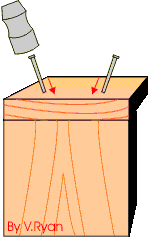| CLICK HERE FOR INDEX PAGE | ||
| TYPES OF NAILS | ||
| V. Ryan © 2002 - 2019 | ||
|
PDF FILE: CLICK HERE FOR PRINTABLE EXERCISE BASED ON WORK SHOWN BELOW |
||
|
Using nails is an effective way of fixing or joining pieces of softwood together. Hardwoods can be difficult to join with nails as they tend to bend under the impact of the hammer. Below is a range of nails that can be used depending on the type of wood and the nature of the work to be attempted. |
||
|
ROUND WIRE NAIL - This is used for general work. It is not attractive in shape and it can split wood when hammered in position |
||
 |
||
|
OVAL WIRE NAIL - This is a long nail and care must be taken when it is hammered into the wood. It is unlikely to split the wood. |
||
 |
||
|
LOST HEAD NAIL - This is ideal if it is necessary to hide the head of the nail as a punch can be used to hammer the head beneath the surface level. |
||
 |
||
|
PANEL PIN - A very popular way of joining woods although glue is usually included as part of the join. |
||
 |
||
|
TACK - Can be used for fixing textile materials to wood for example, fixing upholstery to furniture. |
||
 |
||
|
SPRIG - This no head and is generally used for fixing glass to glass in wood frames. |
||
 |
||
|
ANNULAR NAIL - The teeth of this nail hold it in place firmly. Therefore, it is used for fixing plywood and other materials. |
||
 |
||
| HARDBOARD PIN - The diamond shaped head is hidden when used in materials like hardboard | ||
 |
||
| CORRUGATED FASTENER - This will hold the corners of wood frames firmly together | ||
 |
||
| SPIRAL SHANK NAIL - These are used throughout the construction industry, to firmly attach wood frames (such as shelves) to concrete and masonry. |  |
|
| BRIGHT OVAL HEAD NAILS - These nails are designed to minimise the risk of splitting the end grain of natural wood. They are slightly ‘flattened’ in profile. |  |
|
| MASONRY NAILS - These nails are used on masonry and even brick. |  |
|
|
TYPICAL USE OF NAILING - Dovetail nailing grips both pieces of wood better than hammering the nails straight into the work. as the diagram shows, the nails are angled towards each other and this makes it a little more difficult for the two pieces of wood to be pulled apart. A punch can then be used to tap the heads of the nail slightly below the surface of the wood. This is a typical use of nail in a school workshop. Often panel pins are used in this way. |
|
|
